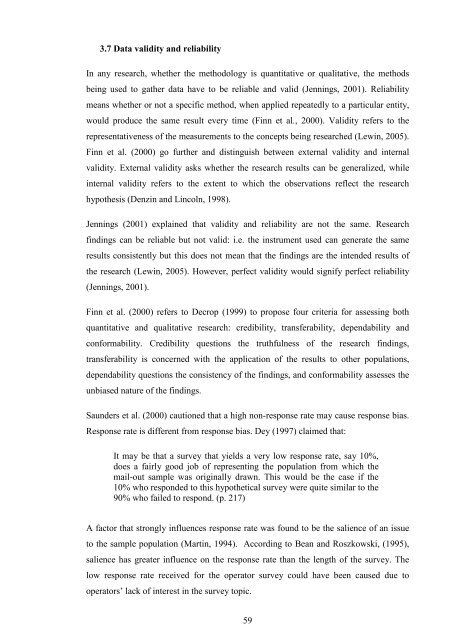The Role of Local Food in Maldives Tourism - Scholarly Commons ...
The Role of Local Food in Maldives Tourism - Scholarly Commons ...
The Role of Local Food in Maldives Tourism - Scholarly Commons ...
Create successful ePaper yourself
Turn your PDF publications into a flip-book with our unique Google optimized e-Paper software.
3.7 Data validity and reliability<br />
In any research, whether the methodology is quantitative or qualitative, the methods<br />
be<strong>in</strong>g used to gather data have to be reliable and valid (Jenn<strong>in</strong>gs, 2001). Reliability<br />
means whether or not a specific method, when applied repeatedly to a particular entity,<br />
would produce the same result every time (F<strong>in</strong>n et al., 2000). Validity refers to the<br />
representativeness <strong>of</strong> the measurements to the concepts be<strong>in</strong>g researched (Lew<strong>in</strong>, 2005).<br />
F<strong>in</strong>n et al. (2000) go further and dist<strong>in</strong>guish between external validity and <strong>in</strong>ternal<br />
validity. External validity asks whether the research results can be generalized, while<br />
<strong>in</strong>ternal validity refers to the extent to which the observations reflect the research<br />
hypothesis (Denz<strong>in</strong> and L<strong>in</strong>coln, 1998).<br />
Jenn<strong>in</strong>gs (2001) expla<strong>in</strong>ed that validity and reliability are not the same. Research<br />
f<strong>in</strong>d<strong>in</strong>gs can be reliable but not valid: i.e. the <strong>in</strong>strument used can generate the same<br />
results consistently but this does not mean that the f<strong>in</strong>d<strong>in</strong>gs are the <strong>in</strong>tended results <strong>of</strong><br />
the research (Lew<strong>in</strong>, 2005). However, perfect validity would signify perfect reliability<br />
(Jenn<strong>in</strong>gs, 2001).<br />
F<strong>in</strong>n et al. (2000) refers to Decrop (1999) to propose four criteria for assess<strong>in</strong>g both<br />
quantitative and qualitative research: credibility, transferability, dependability and<br />
conformability. Credibility questions the truthfulness <strong>of</strong> the research f<strong>in</strong>d<strong>in</strong>gs,<br />
transferability is concerned with the application <strong>of</strong> the results to other populations,<br />
dependability questions the consistency <strong>of</strong> the f<strong>in</strong>d<strong>in</strong>gs, and conformability assesses the<br />
unbiased nature <strong>of</strong> the f<strong>in</strong>d<strong>in</strong>gs.<br />
Saunders et al. (2000) cautioned that a high non-response rate may cause response bias.<br />
Response rate is different from response bias. Dey (1997) claimed that:<br />
It may be that a survey that yields a very low response rate, say 10%,<br />
does a fairly good job <strong>of</strong> represent<strong>in</strong>g the population from which the<br />
mail-out sample was orig<strong>in</strong>ally drawn. This would be the case if the<br />
10% who responded to this hypothetical survey were quite similar to the<br />
90% who failed to respond. (p. 217)<br />
A factor that strongly <strong>in</strong>fluences response rate was found to be the salience <strong>of</strong> an issue<br />
to the sample population (Mart<strong>in</strong>, 1994). Accord<strong>in</strong>g to Bean and Roszkowski, (1995),<br />
salience has greater <strong>in</strong>fluence on the response rate than the length <strong>of</strong> the survey. <strong>The</strong><br />
low response rate received for the operator survey could have been caused due to<br />
operators’ lack <strong>of</strong> <strong>in</strong>terest <strong>in</strong> the survey topic.<br />
59

















